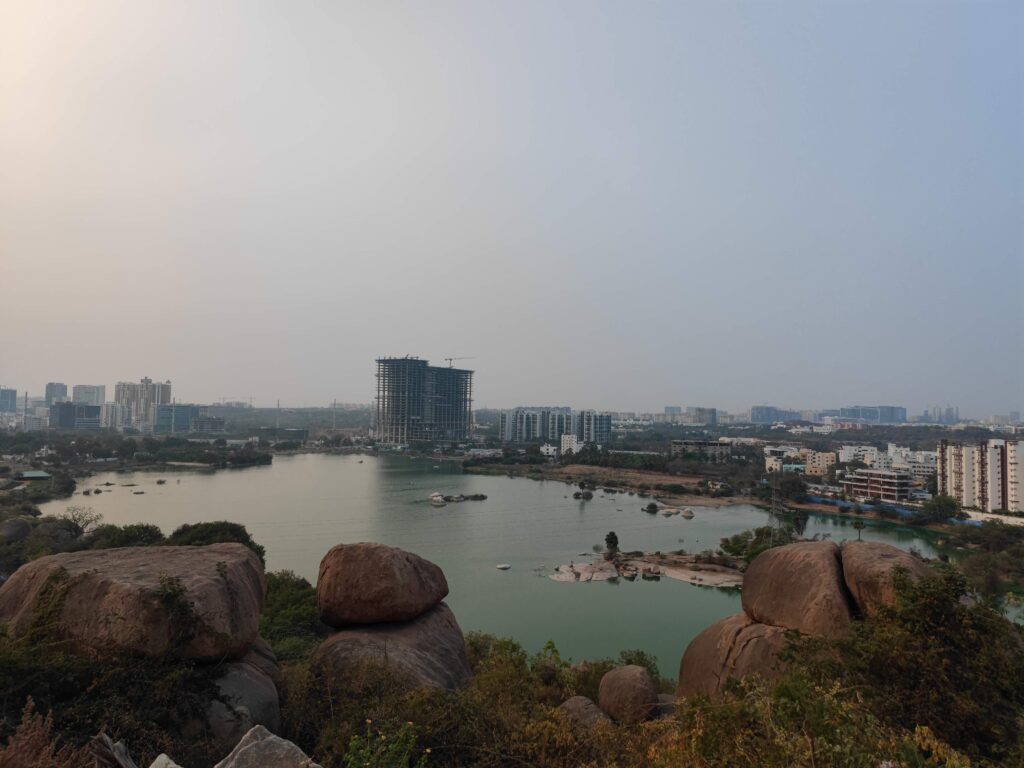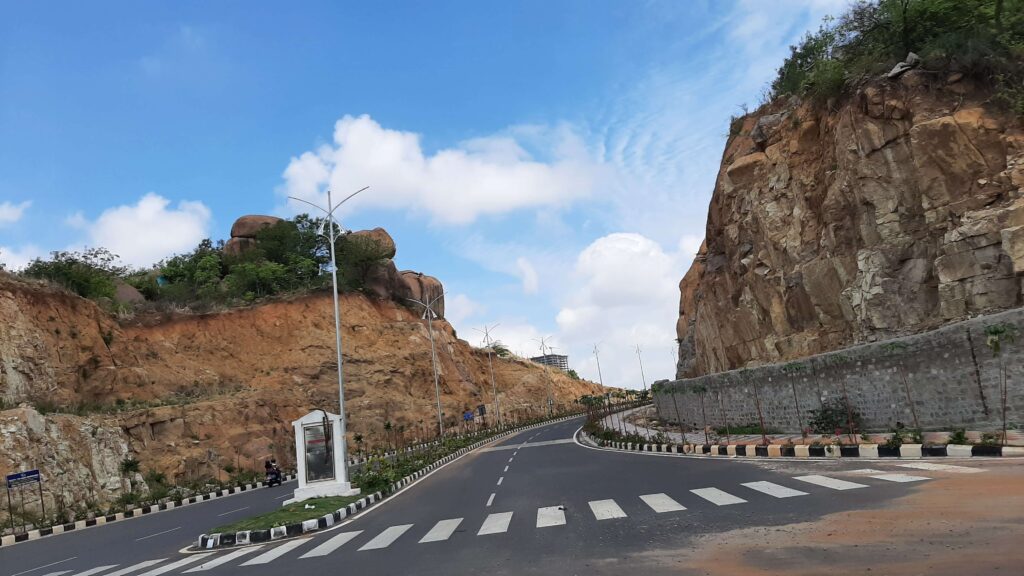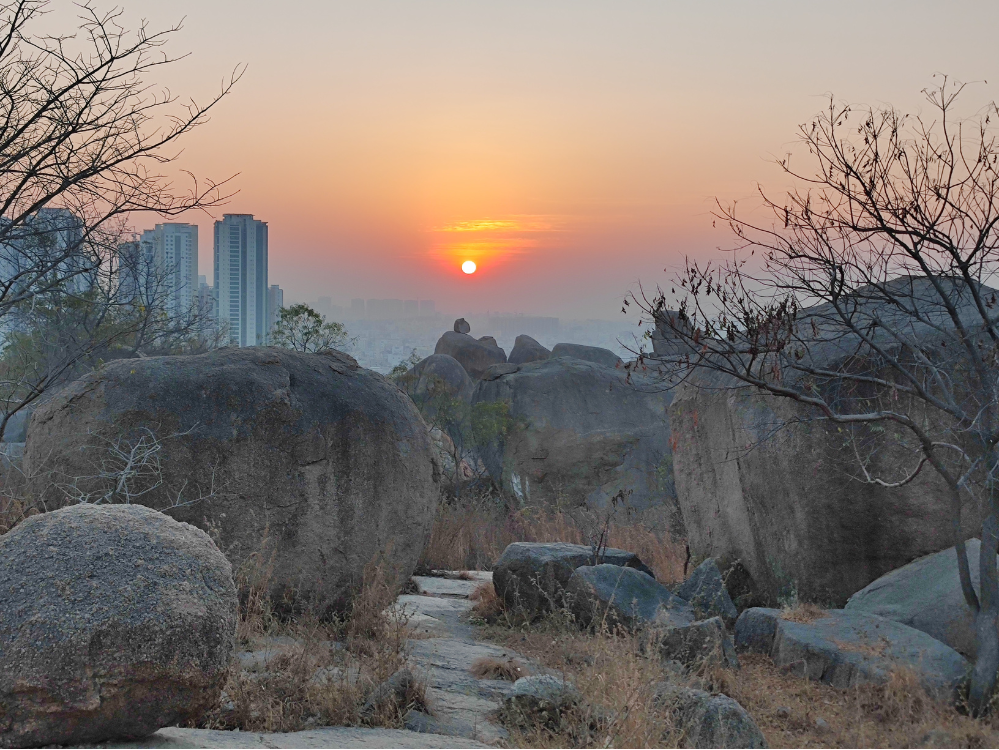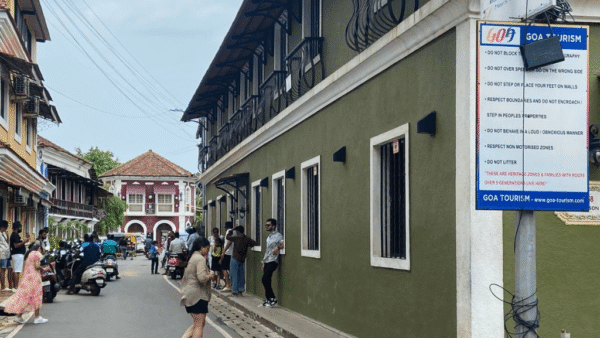About a decade ago, when I first crossed the Rajiv Gandhi International Airport in Hyderabad to reach Srisailam Highway, something peculiar caught my eye. I was shocked to see that the road I was driving on was built by drilling and blasting through huge rocks.
Back then, my interest in documenting Hyderabad’s heritage and history had not yet kicked in but I was dismayed to see the ancient rocks – a landmark for the city – destroyed for ‘development works’.
The rocks which gave way for the airport (to Srisailam highway) road, were part of Hyderabad’s natural rocky terrain. Such destruction of rocks around the city has rapidly increased since then, and has unfortunately reached the Khajaguda rocks, recorded in history as Fakhruddin Gutta (hill). This formation near the famous Golconda Fort, and other rock formations in the area, are said to go back millions of years. The Khajaguda Rocks, spread over 150 acres, are a natural landmark of Hyderabad which offer a bird’s eye view of the fast-expanding city.
However, the site is more than a mere landmark; it’s part of the natural landscape around the old core of Hyderabad city which has extended in all directions but certainly to its west where lies the Golconda Fort, considered the epicentre of the old city. Hyderabad, which shares Lake Husain Sagar with its twin city Secunderabad, had barely 1.1 million people in 1950 but economic growth saw the population rise to nearly 5 million as India’s liberalisation and globalisation were ushered in the early 1990s.
The city, initially promoted as the Infotech hub of India and then as a destination for pharma, automobile and financial services, began expanding towards the Golconda Fort as the Gachibowli address acquired a sheen of its own. As its economy grew and population numbers saw a rise – the Census 2011 put it at nearly 7 million but estimates are that the city’s population would be well in the region of 10 to 11 million now – areas which were farther out and considered uninhabitable or historically significant, such as the Khajaguda Rocks, were sought to be integrated into the city.
The latest assault
The last six years have seen the site lose a substantial portion of the rocks due to rapid urbanisation. After the creation of the Greater Hyderabad Municipal Corporation in 2007, the city’s area shot up from 175 square kilometres then to 650 square kilometres today.
About 20 minutes away from Amazon’s campus and the Indian School of Business site in Gachibowli, this area is prime land both for residential and commercial development. With the nearest Metro station at Raidurg, areas of Gachibowli and Khajaguda are fast becoming populated.
An area which was once a quiet village has witnessed in the last few years a frenzy of construction activities – swanky glass-façade offices, posh high-rises and wide roads have changed the landscape. Going up the hill, along the rocks, it is easy to see new construction – euphemism for ‘urban development’ – that has come up on the foothills of the site.
Just like the Airport Road, major residential or commercial buildings in the HITEC City area besides a host of large-scale constructions are being carried out by blasting through the ancient rocks. Now surrounded by the IT corridor and near the Outer Ring Road, the Khajaguda Rocks area is a favourite among realtors and builders who have encroached at will and blasted through the rocks.
Activists and trekkers who have been visiting the Khajaguda Rocks in the last decade say that many of the huge boulders at its peak have been covered due to debris dumped by local real estate developers, while other rocks in and around the site have been completely destroyed. There are barely any maps or records of what the original site used to be.
Rock climbers and trekkers, along with activists, flagged off the destruction of the heritage site in January-February this year. They found that debris had been dumped on the Rocks, the flora-fauna disturbed, several trees had been cleared, and the ground had been levelled off in places. This intrusion was to facilitate the construction of roads, including one connecting to Outer Ring Road.

Photo: Yunus Lasania
Local activism to save ecology
Avid rock climber Rithwik Reddy, who runs his family’s printing business, would often spot rabbits, monkeys and even wild boars at the Khajaguda Rocks site as recently as 2014. A few years ago, a road was constructed at the base of the temple to reach the hill. And that’s when, he remembers, that things went downhill for the site.
“In 2014, you could not even take your vehicle up the hillock and visitors would have to climb their way up. Each rock is important and we have named them. We started noticing that some of the big rocks had been broken and debris dumped below. We approached the high court in 2019,” Reddy said.
Hearing the petition, the Telangana High Court stopped construction work but when encroachments continued, the alarmed locals decided to take the matter into their own hands. This January alone, around 80 trees died after debris was dumped at the site.
On February 10 this year, residents and activists staged a huge protest at the Khajaguda Rocks site. Ten days later, they put up boards in English and Telugu citing the 2019 court order after which the state government woke up to the issue and filed an FIR against four people for destroying the rocks.
The temple, said an activist who wished to remain anonymous, was a front by local real estate companies or developers who wanted to encroach into the area for their projects. Real estate prices around Khajaguda have increased by 100 per cent in the past few years.
An acre of land is sold for a staggering Rs 45 crore at Khajaguda, according to real estate developers. Property prices keep increasing as you go towards Gachibowli or the Financial District area. About a decade ago, prices used to be Rs 10 crore an acre but are reportedly many times that now. The land prices at Khajaguda also shot up owing to the difficulty in constructing around the natural rock formations. It is also marketed as an area with natural beauty, and government laws can be easily circumvented, say developers.
The rising demand for land means that larger parts of the Khajaguda Rocks area have come under the ‘development’ zone. At stake are nearly 20 erosional rock formations of gneissic granite, traced back to when the earth’s crust was formed. The uniqueness of the Khajaguda Rocks is also from the fact that it has cave or open cave formations, not usually seen in this granite formations.
Alongside heritage is ecology
The indisputable pre-historic value of the Khajaguda Rocks is enhanced by the wide range of flora and fauna that it supports. The heritage is a significant aspect and the rock formations need to be protected for what they are, but there’s also the ecological aspect that rarely enters the debates around urban development.
The site had a sizeable forest patch with several species of plants and trees, including the Parijata or night flowering jasmine, the Indian screw tree (Helicteres isora), the Indian ash trees, East Indian satinwood, Indian Laburnum, Ficus, Ziziphus, Neem, Indian Ash, Pala Indigo, Sitaphal (custard apple), Haldu, Governor’s Plum, and Sea Lemon. Many of these, apparently, have not been recorded by the Botanical Survey of India.
“There is a lot of flora-fauna at the Khajaguda Rocks, with 10,000 trees covering the area,” said Arun Vasireddy, an activist involved in saving the rocks. He added there are over 48 species of trees at the Khajaguda Rocks site. “Some trees shed leaves and create a ‘forest floor mat’ or ‘carpet’, which houses a lot of insects, adding to the ecosystem,” added Vasireddy.
According to activists and local media reports, more than 200 trees, including Neem, Sitaphal and Parijaat, have been axed since 2020.
The Deccan plateau is one of the world’s most stable land masses, even older than the Himalayas, which actually shows the various stages of geological development and age-long weathering of the region. Protecting old rock formations is more than a historic responsibility, it becomes part of conserving the natural ecology and integrating it – rather than tearing it down – in urban plans.
Ecology or natural areas, especially ancient sites such as the Khajaguda Rocks, are rarely considered worthy of conservation and integration into a city. The conventional idea of ‘development’ sees these as expendable or superfluous, something that can be done away with to fit in swanky new buildings and large-scale construction projects.
Besides the Khajaguda Rock site, Hyderabad also has local shrines like Moula Ali and Pahadi Shareef which have been built on huge rocks. The Golconda rulers, or Qutb Shahi (1518-1687) kings, seemed to have understood and valued the natural ecology of the area. The massive Golconda Fort itself – another historical landmark of the city — was built harnessing the naturally formed rocks rather than tunnelling and blasting them down.
The Khajaguda Rocks site falls under the protection of the Hyderabad Metropolitan Development Authority (HMDA), which along with the Greater Hyderabad Municipal Corporation (GHMC), is supposed to safeguard it from intruders and encroachments. Both the authorities have been served notices by the Telangana High Court against further blasting or demolitions of the Khajaguda Rocks – to little success.
Build around, not on the rocks
The ecological protection of the Khajaguda Rocks should have come from its notification as a heritage site in 2009 when 15-20 formations were tagged as ‘heritage precincts’ under the Hyderabad Urban Development Authority Zoning Regulations, 1981. Since historical sites could not be tampered with or built upon, the natural ecology of Khajaguda Rocks was also protected.
The heritage status was withdrawn in 2017 after the Telangana government did away with the Regulation itself. This made Khajaguda Rocks an open area for land developers and realtors. The destruction of the rocks and boulders gathered momentum. The Society to Save the Rocks, a collective of activists and climbers and citizens, challenged this in the high court which issued notices to the authorities.
The Telangana High Court had ruled, “The boulders and the rock forms within and surrounding the city of Hyderabad give a distinct identity to the city, and to the state. These rock forms and boulders are essential to the landscape of the city. Hence, it is imperative that these boulders and rock forms are preserved as far as possible by the state.”
Going beyond the petitioners’ plea to protect the Khajaguda site, the court instructed the state government to plan for the protection of the city’s rock heritage. Forget a comprehensive plan for all rock formations, the blasting and drilling of the rock formations at Khajaguda continues.
In the process, the green cover of the area has shrunk and the varieties of flora-fauna affected as around 200 trees have been axed. The vanishing green cover and the gradual destruction of the age-old rocks and boulders is not the only issue here. The construction of roads and luxury apartments on the rock site also means that other natural eco-systems have been damaged or tampered with. The flow of water in the area is an example.
“This is a big risk…The levelling of the Khajaguda hills will alter the drainage path. The rain water which was flowing naturally in a particular direction will now change course,” said Anant Maringanti, director of Hyderabad Urban Lab, a research organisation.
The “unmapping” of the city – which means the loss of survey maps and other documents – has worked in favour of land grabbers, he said. “In the 70s, all these places were mapped, surveyed and photographed aerially. In the past few years, with Hyderabad expanding, unmapping has made it possible for land grabbers to sell a plot to five different people,” said Maringanti.

Photo: Shobha Surin
Systematic destruction of landscape
The Khajaguda Rocks site holds importance not only for trekkers and rock climbers, but forms a significant element in the urban landscape of Hyderabad city itself. A change in this or systematic destruction of this landscape cannot but impact the city, especially people who have recently made Khajaguda their address of choice.
Though it is a protected area, there are no clear records of the boundary. The government said it would survey and fence the site but this has been pending since March. The HMDA and the Telangana revenue department officials have been passing the buck. In June, a HMDA official said that there was a delay, and another said it is “not their job”.
“The HMDA is supposed to be the regulator, but it does not have the power to protect the site. The revenue department has to do this which it has not done. This is exactly the process of unmapping and washing of its responsibility to preserve the heritage site,” said Maringanti.
This has made the task difficult for the citizens and activists, who are determined not to leave any stone unturned in their efforts to protect the ancient rocks.
At the rate that the historical Khajaguda rock formations are becoming history, what will be left as urban heritage are the roads and towers. Of equal, if not greater, concern is the fact that, despite the advancement in urban planning and urban design, development and expansion of cities still comes at the cost of its natural heritage and ecology.
Yunus Lasania is a Hyderabad-based journalist with a decade of experience in reporting issues in Andhra Pradesh and Telangana. His deep love for Hyderabad and its history is showcased in his Instagram page, The Hyderabad History Project. He also hosts Beyond Charminar, a podcast series on the history of Hyderabad, focussing on the lesser-known aspects of the city.
Cover photo: Yunus Lasania




